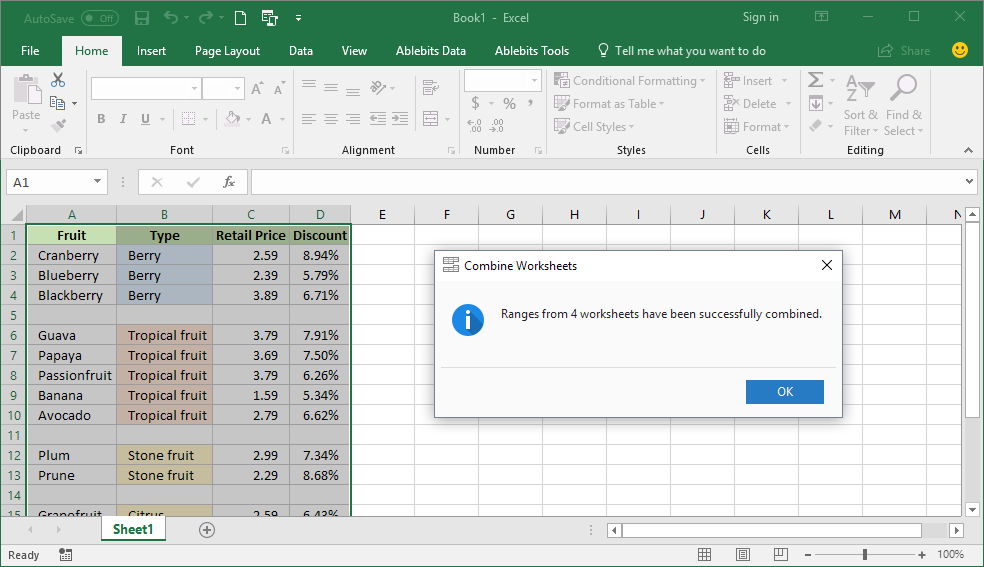3 Simple Ways to Merge Excel Sheets into One

If you regularly work with multiple Excel sheets, you may have encountered situations where merging those separate files into a single document becomes a necessity. Whether you’re compiling data from various departments, aggregating sales figures, or merging project updates, integrating these sheets can save time and streamline data analysis. Here are three simple methods to merge Excel sheets into one:
Method 1: Using Consolidate Function

Steps:
- Open a new Excel workbook.
- Go to the 'Data' tab on the ribbon.
- Click on 'Consolidate' in the 'Data Tools' group.
- In the 'Function' dropdown, select the operation you want to perform on the data (e.g., Sum, Count, Average).
- Click 'Add' to include the range from each of your source workbooks.
- Repeat the process for all workbooks you want to merge.
- Choose where you want the consolidated data to appear. This can be in the active workbook or a new worksheet.
- Select the labels you want to use (row/column headings) and if you want to link the source workbooks.
- Press 'OK' to merge the data.
📝 Note: If you choose to link the source, any changes in the original data will be reflected in your consolidated sheet.
Method 2: Power Query

Power Query is a powerful tool within Excel that can handle more complex merging tasks. Here’s how to use it:
Steps:

- On the ‘Data’ tab, select ‘Get Data’ > ‘From Other Sources’ > ‘From Table/Range’.
- Select the range you want to merge from each source workbook, then click ‘Load’ to load data into Power Query.
- Open the ‘Home’ tab in the Power Query Editor and click ‘Append Queries’.
- Choose ‘Append Queries as New’ to create a new query or ‘Append Queries’ to add to an existing one.
- Select the queries you want to merge, then click ‘OK’.
- Review your data in the Preview window, then click ‘Close & Load’ to load the merged data into Excel.
🔍 Note: Power Query is ideal for merging multiple sheets with different structures. It allows for data transformation and cleaning before merging.
Method 3: VBA Macro

If you need to perform the merging task regularly, a VBA macro can automate the process:
Steps:

- Open the VBA editor by pressing Alt+F11.
- Insert a new module by selecting ‘Insert’ > ‘Module’.
- Copy and paste the following VBA code into the module:
Sub MergeSheets() Dim ws As Worksheet Dim Target As Worksheet Dim FileName As String Dim Path As StringPath = "C:\YourFolderPath\" FileName = Dir(Path & "*.xls*") Set Target = ThisWorkbook.Sheets.Add Target.Name = "Consolidated Sheet" Do While FileName <> "" Workbooks.Open FileName:=Path & FileName, ReadOnly:=True For Each ws In Workbooks(FileName).Worksheets ws.Copy After:=Target Next ws Workbooks(FileName).Close FileName = Dir() LoopEnd Sub - Change “C:\YourFolderPath\” to the path where your Excel files are stored.
- Run the macro by pressing F5 or create a button to execute it.
⚠️ Note: Ensure all files are in the same folder for this method to work seamlessly. Adjust the path in the macro to match your environment.
The ability to merge Excel sheets efficiently not only saves time but also reduces the likelihood of human error. Whether you choose to use the built-in Consolidate Function, leverage Power Query for more complex data structures, or automate the process with VBA macros, each method has its unique advantages. These techniques can significantly enhance productivity and ensure your data analysis is thorough and accurate.
Understanding these tools and their applications allows you to manage your data more effectively, creating a streamlined workflow that can adapt to various scenarios in your work or personal life.
Can I merge sheets with different structures using these methods?

+
Yes, particularly with Power Query, you can transform and structure data from multiple sources before merging. The Consolidate function can also handle discrepancies but might require more manual setup.
Do I need to have all the Excel files open at once?

+
No, especially with methods like VBA and Power Query, you can reference files directly from their location without opening them.
What happens if there are duplicate headers in my source sheets?

+
When using the Consolidate function, duplicate headers will merge their data according to the chosen function. In Power Query, you can manage duplicates through the query editor before appending. VBA macros will simply copy all sheets, including duplicates, so manual cleanup might be needed afterward.